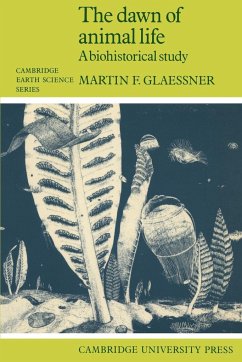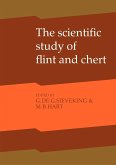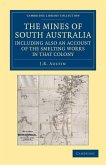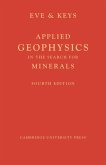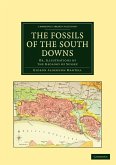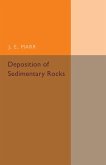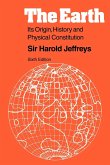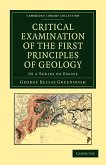- Broschiertes Buch
- Merkliste
- Auf die Merkliste
- Bewerten Bewerten
- Teilen
- Produkt teilen
- Produkterinnerung
- Produkterinnerung
This 1985 book examines the origin of the present diversity of marine invertebrate animals.
Andere Kunden interessierten sich auch für
![The Scientific Study of Flint and Chert The Scientific Study of Flint and Chert]() The Scientific Study of Flint and Chert32,99 €
The Scientific Study of Flint and Chert32,99 €![The Mines of South Australia, Including Also an Account of the Smelting Works in That Colony The Mines of South Australia, Including Also an Account of the Smelting Works in That Colony]() J. B. AustinThe Mines of South Australia, Including Also an Account of the Smelting Works in That Colony31,99 €
J. B. AustinThe Mines of South Australia, Including Also an Account of the Smelting Works in That Colony31,99 €![Applied Geophysics in the Search for Minerals Applied Geophysics in the Search for Minerals]() A. S. EveApplied Geophysics in the Search for Minerals68,99 €
A. S. EveApplied Geophysics in the Search for Minerals68,99 €![The Fossils of the South Downs The Fossils of the South Downs]() Gideon Algernon MantellThe Fossils of the South Downs59,99 €
Gideon Algernon MantellThe Fossils of the South Downs59,99 €![Deposition of the Sedimentary Rocks Deposition of the Sedimentary Rocks]() J. E. MarrDeposition of the Sedimentary Rocks48,99 €
J. E. MarrDeposition of the Sedimentary Rocks48,99 €![The Earth The Earth]() Harold JeffreysThe Earth96,99 €
Harold JeffreysThe Earth96,99 €![Critical Examination of the First Principles of Geology Critical Examination of the First Principles of Geology]() George Bellas GreenoughCritical Examination of the First Principles of Geology50,99 €
George Bellas GreenoughCritical Examination of the First Principles of Geology50,99 €-
-
This 1985 book examines the origin of the present diversity of marine invertebrate animals.
Hinweis: Dieser Artikel kann nur an eine deutsche Lieferadresse ausgeliefert werden.
Hinweis: Dieser Artikel kann nur an eine deutsche Lieferadresse ausgeliefert werden.
Produktdetails
- Produktdetails
- Verlag: Cambridge University Press
- Seitenzahl: 258
- Erscheinungstermin: 20. Oktober 2010
- Englisch
- Abmessung: 229mm x 152mm x 15mm
- Gewicht: 424g
- ISBN-13: 9780521312165
- ISBN-10: 0521312167
- Artikelnr.: 26948179
- Herstellerkennzeichnung
- Libri GmbH
- Europaallee 1
- 36244 Bad Hersfeld
- gpsr@libri.de
- Verlag: Cambridge University Press
- Seitenzahl: 258
- Erscheinungstermin: 20. Oktober 2010
- Englisch
- Abmessung: 229mm x 152mm x 15mm
- Gewicht: 424g
- ISBN-13: 9780521312165
- ISBN-10: 0521312167
- Artikelnr.: 26948179
- Herstellerkennzeichnung
- Libri GmbH
- Europaallee 1
- 36244 Bad Hersfeld
- gpsr@libri.de
List of figures and tables
Preface
1. Precambrian life and its environment: a review: i. Theories about the origin of life and its environment
ii. The Precambrian, its subdivisions, and the dating of biohistoric events
iii. The preservation and recognition of organic remains in rocks: chemofossils, fossil organisms, pseudofossils
iv. The cell: organization and life processes. The 'kingdoms' of organisms
v. Proterozoic fossils and environments
vi. Origins and early differentiation of the Metazoa
2. The Ediacarian faunal assemblages: discovery, composition, significance
i. Discoveries at Ediacara
ii. Palaeoenvironment and fossilization
iii. Composition of the fauna
iv. Paleobiology
v. Other occurrences of Late Precambrian Metazoa in Australia
vi. The Nama fauna of southwestern Africa (Namibia) and possible equivalents in South America
vii. Late Precambrian Metazoa from the Northern Hemisphere
viii. The concept of Ediacarian fauna
3. The Precambrian diversification of the Metazoa in the light of paleozoology: i. The significance of the Ediacarian fauna for metazoan phylogeny
ii. Re-assessment of the incompleteness of the palaeontological record
iii. The record of the Late Precambrian fauna applied to problems of phylogeny
iv. Occupation of the marine environment: habitats and habits
v. Conclusions on the physical environments of the Late Precambrian Metazoa
vi. The taxonomy of emerging diversity: the meaning of phyla
vii. Rates of evolution
4. The Precambrian-Cambrian transition: i. Stratigraphic scales: boundaries and historical transitions
ii. The fate of the Ediacarian faunas: extinction, survival, replacement
iii. The Cambrian Period as the time of the first shelly fossils
iv. the oldest Cambrian faunas and their evolutionary antecedents
v. Agglutinated, chitinous and mineralized body components in Ediacarian fossils and in some successors
vi. Extrinsic and internal factors of biomineralisation and its functional significance
vii. Environmental changes at the Precambrian-Cambrian transition
viii. Increase in diversity of trace fossils
ix. Consequences and causes of evolutionary diversification
5. Emerging animal life: thoughts on interactions of lithosphere, hydrosphere, atmosphere and biosphere: i. Interactions of intrinsic and environmental factors in the emergent biosphere
ii. Metazoan expansion in the marine biosphere: a three-stage process
iii. Interactions in the light of plate tectonics
iv. Animal life: past, present and future
Appendix
References
Dictionaries of scientific terms
Author index
Subject index.
Preface
1. Precambrian life and its environment: a review: i. Theories about the origin of life and its environment
ii. The Precambrian, its subdivisions, and the dating of biohistoric events
iii. The preservation and recognition of organic remains in rocks: chemofossils, fossil organisms, pseudofossils
iv. The cell: organization and life processes. The 'kingdoms' of organisms
v. Proterozoic fossils and environments
vi. Origins and early differentiation of the Metazoa
2. The Ediacarian faunal assemblages: discovery, composition, significance
i. Discoveries at Ediacara
ii. Palaeoenvironment and fossilization
iii. Composition of the fauna
iv. Paleobiology
v. Other occurrences of Late Precambrian Metazoa in Australia
vi. The Nama fauna of southwestern Africa (Namibia) and possible equivalents in South America
vii. Late Precambrian Metazoa from the Northern Hemisphere
viii. The concept of Ediacarian fauna
3. The Precambrian diversification of the Metazoa in the light of paleozoology: i. The significance of the Ediacarian fauna for metazoan phylogeny
ii. Re-assessment of the incompleteness of the palaeontological record
iii. The record of the Late Precambrian fauna applied to problems of phylogeny
iv. Occupation of the marine environment: habitats and habits
v. Conclusions on the physical environments of the Late Precambrian Metazoa
vi. The taxonomy of emerging diversity: the meaning of phyla
vii. Rates of evolution
4. The Precambrian-Cambrian transition: i. Stratigraphic scales: boundaries and historical transitions
ii. The fate of the Ediacarian faunas: extinction, survival, replacement
iii. The Cambrian Period as the time of the first shelly fossils
iv. the oldest Cambrian faunas and their evolutionary antecedents
v. Agglutinated, chitinous and mineralized body components in Ediacarian fossils and in some successors
vi. Extrinsic and internal factors of biomineralisation and its functional significance
vii. Environmental changes at the Precambrian-Cambrian transition
viii. Increase in diversity of trace fossils
ix. Consequences and causes of evolutionary diversification
5. Emerging animal life: thoughts on interactions of lithosphere, hydrosphere, atmosphere and biosphere: i. Interactions of intrinsic and environmental factors in the emergent biosphere
ii. Metazoan expansion in the marine biosphere: a three-stage process
iii. Interactions in the light of plate tectonics
iv. Animal life: past, present and future
Appendix
References
Dictionaries of scientific terms
Author index
Subject index.
List of figures and tables
Preface
1. Precambrian life and its environment: a review: i. Theories about the origin of life and its environment
ii. The Precambrian, its subdivisions, and the dating of biohistoric events
iii. The preservation and recognition of organic remains in rocks: chemofossils, fossil organisms, pseudofossils
iv. The cell: organization and life processes. The 'kingdoms' of organisms
v. Proterozoic fossils and environments
vi. Origins and early differentiation of the Metazoa
2. The Ediacarian faunal assemblages: discovery, composition, significance
i. Discoveries at Ediacara
ii. Palaeoenvironment and fossilization
iii. Composition of the fauna
iv. Paleobiology
v. Other occurrences of Late Precambrian Metazoa in Australia
vi. The Nama fauna of southwestern Africa (Namibia) and possible equivalents in South America
vii. Late Precambrian Metazoa from the Northern Hemisphere
viii. The concept of Ediacarian fauna
3. The Precambrian diversification of the Metazoa in the light of paleozoology: i. The significance of the Ediacarian fauna for metazoan phylogeny
ii. Re-assessment of the incompleteness of the palaeontological record
iii. The record of the Late Precambrian fauna applied to problems of phylogeny
iv. Occupation of the marine environment: habitats and habits
v. Conclusions on the physical environments of the Late Precambrian Metazoa
vi. The taxonomy of emerging diversity: the meaning of phyla
vii. Rates of evolution
4. The Precambrian-Cambrian transition: i. Stratigraphic scales: boundaries and historical transitions
ii. The fate of the Ediacarian faunas: extinction, survival, replacement
iii. The Cambrian Period as the time of the first shelly fossils
iv. the oldest Cambrian faunas and their evolutionary antecedents
v. Agglutinated, chitinous and mineralized body components in Ediacarian fossils and in some successors
vi. Extrinsic and internal factors of biomineralisation and its functional significance
vii. Environmental changes at the Precambrian-Cambrian transition
viii. Increase in diversity of trace fossils
ix. Consequences and causes of evolutionary diversification
5. Emerging animal life: thoughts on interactions of lithosphere, hydrosphere, atmosphere and biosphere: i. Interactions of intrinsic and environmental factors in the emergent biosphere
ii. Metazoan expansion in the marine biosphere: a three-stage process
iii. Interactions in the light of plate tectonics
iv. Animal life: past, present and future
Appendix
References
Dictionaries of scientific terms
Author index
Subject index.
Preface
1. Precambrian life and its environment: a review: i. Theories about the origin of life and its environment
ii. The Precambrian, its subdivisions, and the dating of biohistoric events
iii. The preservation and recognition of organic remains in rocks: chemofossils, fossil organisms, pseudofossils
iv. The cell: organization and life processes. The 'kingdoms' of organisms
v. Proterozoic fossils and environments
vi. Origins and early differentiation of the Metazoa
2. The Ediacarian faunal assemblages: discovery, composition, significance
i. Discoveries at Ediacara
ii. Palaeoenvironment and fossilization
iii. Composition of the fauna
iv. Paleobiology
v. Other occurrences of Late Precambrian Metazoa in Australia
vi. The Nama fauna of southwestern Africa (Namibia) and possible equivalents in South America
vii. Late Precambrian Metazoa from the Northern Hemisphere
viii. The concept of Ediacarian fauna
3. The Precambrian diversification of the Metazoa in the light of paleozoology: i. The significance of the Ediacarian fauna for metazoan phylogeny
ii. Re-assessment of the incompleteness of the palaeontological record
iii. The record of the Late Precambrian fauna applied to problems of phylogeny
iv. Occupation of the marine environment: habitats and habits
v. Conclusions on the physical environments of the Late Precambrian Metazoa
vi. The taxonomy of emerging diversity: the meaning of phyla
vii. Rates of evolution
4. The Precambrian-Cambrian transition: i. Stratigraphic scales: boundaries and historical transitions
ii. The fate of the Ediacarian faunas: extinction, survival, replacement
iii. The Cambrian Period as the time of the first shelly fossils
iv. the oldest Cambrian faunas and their evolutionary antecedents
v. Agglutinated, chitinous and mineralized body components in Ediacarian fossils and in some successors
vi. Extrinsic and internal factors of biomineralisation and its functional significance
vii. Environmental changes at the Precambrian-Cambrian transition
viii. Increase in diversity of trace fossils
ix. Consequences and causes of evolutionary diversification
5. Emerging animal life: thoughts on interactions of lithosphere, hydrosphere, atmosphere and biosphere: i. Interactions of intrinsic and environmental factors in the emergent biosphere
ii. Metazoan expansion in the marine biosphere: a three-stage process
iii. Interactions in the light of plate tectonics
iv. Animal life: past, present and future
Appendix
References
Dictionaries of scientific terms
Author index
Subject index.

